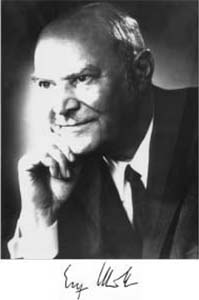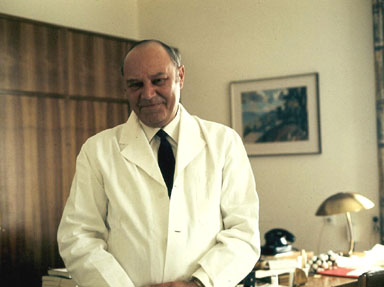|

|
| |
|
 |
|
Eugen Müller |
*21.6.1905
†26.7.1976
in Tübingen
1957-1975
|
| |
|
| |
|
| |
|
| |
|
| |
|
| |
|
|
|
|
back to History
|
|
|
|
|
taken
from: G. Häfelinger,
Eu J. Org. Chem. 2008, 3731-3746.
 Eugen
Friedrich Wilhelm Müller was born on June 21, 1905 in Merken near
Düren in Rhineland as the son of the (later independent) paper
merchant Friedrich Müller and wife Claire Müller, née Freiberg.
Eugen Müller grew up in Berlin, where, aged 18, he completed his
schooling at the Falk Realgymnasium in 1923. From Easter
1923 to Easter 1925 he studied chemistry at the Friedrich Wilhelm
University in Berlin along with the subjects physics, technology,
and philosophy, for which he completed the first collective
examination with Willy Marckwald. In the summer semester of 1925,
he moved to the Albert Ludwig University at Freiburg in Breisgau,
but then returned to Berlin for the winter semester of 1925.
There, in December 1925, Eugen Müller completed exams in chemistry
with Hofrat (“court councillor”) Wilhelm Schlenk, and in physical
chemistry in March 1926 the second collective exam aged 21 (which
would now correspond to a German “Diplom”). Between the summer
semesters of 1926 and 1927 he completed his dissertation[1] in
Berlin with Wilhelm Schlenk with the title “Über neue
alkaliorganische Verbindungen” (On New Alkaliorganic
Compounds). After completing his PhD, Eugen Müller remained
at the Chemical Institute of the Berlin university from 1928 to
1929, first as an assistant and then as a scholar of the
Notgemeinschaft der Deutschen Wissenschaft (later named
Deutsche Forschungsgemeinschaft, DFG; German Scientific Support
Society). From 1929 to 1933, Eugen Müller worked at the
Technical University in Gdansk/Danzig as a lecturer’s assistant to
Alfred Wohl. On his way to scientific independence, Eugen Müller
showed the cis–trans isomerisation of azoxy
compounds by UV and dipole-moment measurements after preparative
separation.[3] This work led to his “Habilitation” in Danzig on
March 3, 1933 aged 28, with a subsequent appointment as senior
assistant to
Adolf Butenandt. From 1937 to 1941, Eugen
Müller was active at the Friedrich Schiller University in Jena,
initially as senior assistant, and then from 1939 as deputy head
of department in organic chemistry. The continuation of the
magnetochemical investigations resulted in a series of 24
communications. In 1941 he received a chair in organic chemistry
at the University of Frankfurt/Main and was made scientific
director of the newly instigated German Research Institute for
Polymer Chemistry. This institute was however destroyed by a
bombing raid in 1944 a few weeks after it was opened, as was the
Institute for Organic Chemistry and the family’s house in the same
year. He held his chair until after the end of the war in 1945,
when he was dismissed as a consequence of Article 52 of the Allied
Military Law, as he had been a member of the Nazi party since
1935. In 1949, Eugen Müller was asked by Otto Bayer and Hans
Meerwein to become Chief Editor of the Chemiker- Zeitung (Chem.-Ztg.)
and in 1950 the Editor in Charge for the newly conceived fourth
edition of the Houben–Weyl Handbook “Methods of Organic
Chemistry”. In 1949, he turned down offers of chairs in
organic chemistry at the universities of Leipzig and Jena, but
accepted a position as guest professor at the Technical University
of Stuttgart in 1950–1951. On February 2, 1952 he took up a chair
in the Chemical Technology of Synthetic Fibres at the University
of Tübingen, a position which was later renamed Applied Chemistry.
In 1957, Eugen Müller was appointed successor to
Georg Wittig as
the director of the chemical institute of the Eberhard Karls
University in Tübingen. After becoming an emeritus professor in
1973, he continued for a further two years until his successor
Michael Hanack arrived in 1975. A sudden heart attack on July 26,
1976 unexpectedly ended the active working life of Eugen Müller. Eugen
Friedrich Wilhelm Müller was born on June 21, 1905 in Merken near
Düren in Rhineland as the son of the (later independent) paper
merchant Friedrich Müller and wife Claire Müller, née Freiberg.
Eugen Müller grew up in Berlin, where, aged 18, he completed his
schooling at the Falk Realgymnasium in 1923. From Easter
1923 to Easter 1925 he studied chemistry at the Friedrich Wilhelm
University in Berlin along with the subjects physics, technology,
and philosophy, for which he completed the first collective
examination with Willy Marckwald. In the summer semester of 1925,
he moved to the Albert Ludwig University at Freiburg in Breisgau,
but then returned to Berlin for the winter semester of 1925.
There, in December 1925, Eugen Müller completed exams in chemistry
with Hofrat (“court councillor”) Wilhelm Schlenk, and in physical
chemistry in March 1926 the second collective exam aged 21 (which
would now correspond to a German “Diplom”). Between the summer
semesters of 1926 and 1927 he completed his dissertation[1] in
Berlin with Wilhelm Schlenk with the title “Über neue
alkaliorganische Verbindungen” (On New Alkaliorganic
Compounds). After completing his PhD, Eugen Müller remained
at the Chemical Institute of the Berlin university from 1928 to
1929, first as an assistant and then as a scholar of the
Notgemeinschaft der Deutschen Wissenschaft (later named
Deutsche Forschungsgemeinschaft, DFG; German Scientific Support
Society). From 1929 to 1933, Eugen Müller worked at the
Technical University in Gdansk/Danzig as a lecturer’s assistant to
Alfred Wohl. On his way to scientific independence, Eugen Müller
showed the cis–trans isomerisation of azoxy
compounds by UV and dipole-moment measurements after preparative
separation.[3] This work led to his “Habilitation” in Danzig on
March 3, 1933 aged 28, with a subsequent appointment as senior
assistant to
Adolf Butenandt. From 1937 to 1941, Eugen
Müller was active at the Friedrich Schiller University in Jena,
initially as senior assistant, and then from 1939 as deputy head
of department in organic chemistry. The continuation of the
magnetochemical investigations resulted in a series of 24
communications. In 1941 he received a chair in organic chemistry
at the University of Frankfurt/Main and was made scientific
director of the newly instigated German Research Institute for
Polymer Chemistry. This institute was however destroyed by a
bombing raid in 1944 a few weeks after it was opened, as was the
Institute for Organic Chemistry and the family’s house in the same
year. He held his chair until after the end of the war in 1945,
when he was dismissed as a consequence of Article 52 of the Allied
Military Law, as he had been a member of the Nazi party since
1935. In 1949, Eugen Müller was asked by Otto Bayer and Hans
Meerwein to become Chief Editor of the Chemiker- Zeitung (Chem.-Ztg.)
and in 1950 the Editor in Charge for the newly conceived fourth
edition of the Houben–Weyl Handbook “Methods of Organic
Chemistry”. In 1949, he turned down offers of chairs in
organic chemistry at the universities of Leipzig and Jena, but
accepted a position as guest professor at the Technical University
of Stuttgart in 1950–1951. On February 2, 1952 he took up a chair
in the Chemical Technology of Synthetic Fibres at the University
of Tübingen, a position which was later renamed Applied Chemistry.
In 1957, Eugen Müller was appointed successor to
Georg Wittig as
the director of the chemical institute of the Eberhard Karls
University in Tübingen. After becoming an emeritus professor in
1973, he continued for a further two years until his successor
Michael Hanack arrived in 1975. A sudden heart attack on July 26,
1976 unexpectedly ended the active working life of Eugen Müller.

Eugen
Müller 1969 at his office at the lab building Wilhelmstrasse
|
|
|
|
![]()